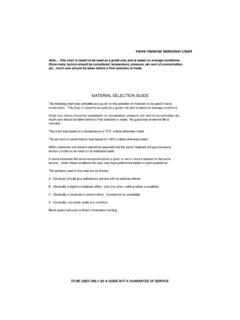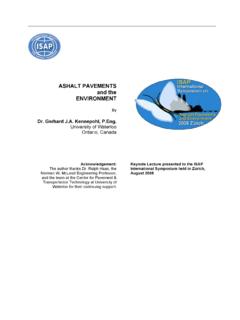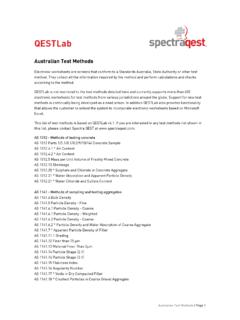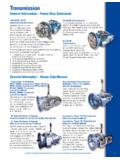Transcription of Basic Asphalt Materials Mixture Design and Testing
1 TECHNICAL BULLETIN Basic Asphalt Materials Mixture Design and Testing Technician Training Manual October 2012 Table of Contents Preface .. 1 Mix Design Fundamentals .. 2 Materials Physical Properties .. 3 Aggregate .. 3 Maximum Size .. 3 Gradation .. 3 Measurement .. 3 Typical HMA Gradations Blend .. 4 Aggregate Gradation Terms .. 4 Other Properties .. 5 Asphalt Cement .. 6 Asphalt Physical Properties .. 6 Grading Systems .. 7 Superpave Performance Grading (PG) System .. 7 Penetration Grading .. 7 Viscosity Grading .. 8 Asphalt Binder Modifiers .. 8 Marshall Method .. 10 Types of Mixes Used in Ontario .. 11 Basic Procedure .. 12 Superpave Mix Design .. 13 Traffic Load 13 PGAC Binder Selection .. 14 Aggregate Size Definitions .. 15 Traffic Categories .. 15 Compaction Effort .. 18 How to Choose .. 19 Mix Design 19 Asphalt Recycling ..32 McAsphalt Industries Limited October 2012 1 Preface This training manual was developed as part of an effort to provide a step-by-step procedure for understanding Basic Asphalt Mixture composition, creating mix designs and recycling processes.
2 McAsphalt Industries Limited October 2012 2 Mix Design Fundamentals HMA consists of two Basic ingredients: aggregate and Asphalt binder. HMA mix Design is the process of determining what aggregate to use, what Asphalt binder to use and what the optimum combination of these two ingredients ought to be. There are several different methods used to go about this process, of which the Marshall and Superpave methods are the most common. By manipulating the variables of aggregate, Asphalt binder and the ratio between the two, mix Design seeks to achieve the following qualities in the final HMA product (Roberts et al., 1996): Deformation resistance: HMA should not distort (rut) or deform (shove) under traffic loading. HMA deformation is related to aggregate surface and abrasion characteristics, aggregate gradation, Asphalt binder content and Asphalt binder viscosity at high temperatures. Fatigue resistance: HMA should not crack when subjected to repeated loads over time.
3 HMA fatigue cracking is related to Asphalt binder content and stiffness. Low temperature cracking resistance: HMA should not crack when subjected to low ambient temperatures. Low temperature cracking is primarily a function of the Asphalt binder low temperature stiffness. Durability: HMA should not age excessively during production and service life. HMA durability is related to air voids as well as the Asphalt binder film thickness around each aggregate particle. Moisture damage resistance: HMA should not degrade substantially from moisture penetration into the mix. Moisture damage resistance is related to air voids as well as aggregate mineral and chemical properties. Skid resistance: HMA placed as a surface course should provide sufficient friction when in contact with a vehicle's tire. Low skid resistance is generally related to aggregate characteristics or high Asphalt binder content. Workability: HMA must be capable of being placed and compacted with reasonable effort.
4 Workability is generally related to aggregate texture/shape/size/gradation, Asphalt binder content and Asphalt binder viscosity at mixing and placement temperatures. McAsphalt Industries Limited October 2012 3 Materials Physical Properties Aggregate Aggregates can be classified by their mineral, chemical and physical properties. The pavement industry typically relies on physical properties for performance characterization. An aggregate's physical properties are a direct result of its mineral and chemical properties. Maximum Size Maximum aggregate size can affect HMA and base/Subbase courses in several ways. In HMA, instability may result from excessively small maximum sizes; and poor workability and/or segregation may result from excessively large maximum sizes (Roberts et al., 1996). ASTM C 125 defines the maximum aggregate size in one of two ways: Maximum size: The smallest sieve through which 100 percent of the aggregate sample particles pass. Superpave defines the maximum aggregate size as "one sieve larger than the nominal maximum size" (Roberts et al.)
5 , 1996). Nominal maximum size: The largest sieve that retains some of the aggregate particles but generally not more than 10 percent by weight. Superpave defines nominal maximum aggregate size as "one sieve size larger than the first sieve to retain more than 10 percent of the material " (Roberts et al., 1996). It is important to specify whether "maximum size" or "nominal maximum size" is being referenced. Gradation An aggregate's particle size distribution, or gradation, is one of its most influential characteristics. In HMA, gradation helps determine almost every important property including stiffness, stability, durability, permeability, workability, fatigue resistance, frictional resistance and resistance to moisture damage (Roberts et al., 1996). Because of this, gradation is a primary concern in HMA mix Design and thus most agencies specify allowable aggregate gradations. Measurement Gradation is usually measured by a sieve analysis. In a sieve analysis, a sample of dry aggregate of known weight is separated through a series of sieves with progressively smaller openings.
6 Once separated, the weight of particles retained on each sieve is measured and compared to the McAsphalt Industries Limited October 2012 4 total sample weight. Particle size distribution is then expressed as a percent passing by weight on each sieve size. Typical HMA Gradations Blend Dense or well-graded: Refers to a gradation that is near maximum density. The most common HMA mix designs tend to use dense graded aggregate. Gap graded: Refers to a gradation that contains only a small percentage of aggregate particles in the mid-size range. The curve is near-horizontal in the mid-size range. These mixes can be prone to segregation during placement. Open graded: Refers to a gradation that contains only a small percentage of aggregate particles in the small range. This results in more air voids because there are not enough small particles to fill in the voids between the larger particles. The curve is near-horizontal and near-zero in the small-size range.
7 Uniformly graded: Refers to a gradation that contains most of the particles in a very narrow size range In essence, all the particles are the same size, The curve is steep and only occupies the narrow size range specified. Aggregate Gradation Terms Fine aggregate: (sometimes just referred to as "fines"). Defined by AASHTO M 147 as natural or crushed sand passing the and mineral particles passing the 75um sieve. Coarse aggregate: Defined by AASHTO M 147 as hard, durable particles or fragments of stone, gravel or slag retained on the sieve. Usually coarse aggregate has a toughness and abrasion resistance requirement. Fine gradation: A gradation that, when plotted on the power gradation graph, falls mostly above the power maximum density line. The term generally applies to dense graded aggregate. Coarse gradation: A gradation that, when plotted on the power gradation graph, falls mostly below the power maximum density line. The term generally applies to dense graded aggregate.
8 Mineral filler: Defined by the Asphalt Institute as a finely divided mineral product at least 65 percent of which will pass through 75um sieve. Pulverized limestone is the most commonly McAsphalt Industries Limited October 2012 5 manufactured mineral filler, although other stone dust, silica, hydrated lime, Portland cement and certain natural deposits of finely divided mineral matter are also used ( Asphalt Institute, 1962). Other Properties Other important aggregate physical properties are: Toughness and abrasion resistance: Aggregates should be hard and tough enough to resist crushing, degradation and disintegration from activities such as manufacturing, stockpiling, placing and compaction. Durability and soundness: Aggregates must be resistant to breakdown and disintegration from weathering (wetting/drying) or else they may break apart and cause premature pavement distress. Particle shape and surface texture: Particle shape and surface texture are important for proper compaction, load resistance and workability.
9 Generally, cubic angular-shaped particles with a rough surface texture are best. Specific gravity: Aggregate specific gravity is useful in making weight-volume conversions and in calculating the void content in compacted HMA (Roberts et al., 1996). Cleanliness and deleterious Materials : Aggregates must be relatively clean when used in HMA. Vegetation, soft particles, clay lumps, excess dust and vegetable matter may affect performance by quickly degrading, which causes a loss of structural support and/or prevents binder-aggregate bonding. McAsphalt Industries Limited October 2012 6 Asphalt Cement Asphalt cement refers to Asphalt that has been prepared for use in HMA and other paving applications. In HMA a generic term, " Asphalt binder", to represent the principal binding agent in HMA because " Asphalt binder" includes Asphalt cement as well as any material added to modify the original Asphalt cement properties. Asphalt Physical Properties Asphalt can be classified by its chemical composition and physical properties.
10 The pavement industry typically relies on physical properties for performance characterization although Asphalt s physical properties are a direct result of its chemical composition. Typically, the most important physical properties are: Durability: Durability is a measure of how Asphalt binder physical properties change with age (sometimes called age hardening). In general, as an Asphalt binder ages, its viscosity increases and it becomes more stiff and brittle. Rheology: Rheology is the study of deformation and flow of matter. Deformation and flow of the Asphalt binder in HMA is important in HMA pavement performance. HMA pavements that deform and flow too much may be susceptible to rutting and bleeding, while those that are too stiff may be susceptible to fatigue cracking. Safety: Asphalt cement like most other Materials , volatilizes (gives off vapor) when heated. At extremely high temperatures (well above those experienced in the manufacture and construction of HMA) Asphalt cement can release enough vapor to increase the volatile concentration immediately above the Asphalt cement to a point where it will ignite (flash) when exposed to a spark or open flame.







